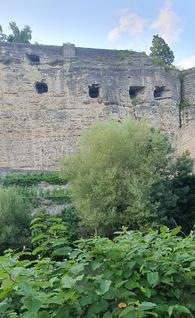Photo. The Bock cliff with loop-holes for the cannons - Exploring the historic wonder of the Bock Casemates in Luxembourg.
In the heart of Luxembourg City lies a place where history lives in stone – the Casemates. There are two casemates in Luxembourg city, the Pétrusse and the Bock - both constructions are a huge system of vaults and subway tunnels that were part of the defences of the city. And full of mysteries. They date from the seventeenth and eighteenth centuries and occupied an area of more than 17 kilometres. The casemates are invitation to explore, to chase the unknown, and to walk in the footsteps of centuries past. Here, adventure runs deep - and mystery waits around every corner.
Eager to explore this vast maze of stone tunnels, I stepped into the stone entrance at Bock Casemates, leaving the bright streets of Luxembourg City behind. The air grew cooler, the light dimmer, as I walked deeper into the huge tunnel complex. Walking there feels like stepping back in time - through the millennial history in the city of Luxembourg.
Beneath Luxembourg City's charming Old Quarter lies a hidden world of tunnels known as the Casemates, part of a fortress so mighty it was once called the “Gibraltar of the North.” Surrounding it are medieval churches, castle ruins, and ancient walls whispering secrets from centuries past.
Built in the 17th century, these tunnels and chambers were carved deep into the rock to protect the city from attack. Once, soldiers and weapons filled these underground halls. Wandering through the narrow labyrinthine passages - and up and down the steep spiral staircases with narrow stair treads, I felt both small and infinite. It was passageways with reduced width and height, so I had to mind my head. This place is definitely not for persons suffering from claustrophobia. I tried as best I could to stay on the marked paths. I knew that if I got completely lost, Google Maps and GPS navigation wouldn’t be there to guide me out.
This system of tunnels runs through the entire old town and extends all the way to the Kirchberg plateau. As I wandered further through the cool, dim passages, I ran my hand along the ancient walls and imagined the stories they could tell. From the openings in the rock, I looked out over the Alzette River valley and the city’s rooftops – a view as breathtaking as the history itself.
The Bock Casemates are not just a UNESCO World Heritage site. They are a living reminder of the skill, courage, and vision that shaped this city. These tunnels, carved into solid rock in the 17th century, once guarded the city against invaders. Soldiers slept here, weapons lay ready, and every echo might have been a warning. Today, only the whispers of history remain.
My footsteps followed the curve of the passages, smooth from centuries of use. At times, narrow openings revealed the city below – the Alzette River winding like a silver ribbon, rooftops glowing in the sun. I paused, imagining the watchmen who once stood here, scanning the horizon for danger.
The country’s official motto is mir wëlle bleiwe wat mir sinn. Meaning ‘we want to remain what we are,’ the motto refers to the country’s tumultuous history and the wish to remain independent (now and in the future). One of the more interesting facts about Luxembourg is that it was passed back and forth between various European powers – from France to the Spanish to the Austrians and back to the French. Over the centuries, three partitions of Luxembourg have reduced the territory from 10,700 km2 (4,100 sq mi) to the present-day area of 2,586 km2 (998 sq mi). The lost regions are now part of modern-day Belgium, France, and Germany (source: Wikipedia).
Luxembourg’s location in the heart of Europe has always been both a blessing and a curse. Sitting on key trade and military routes, it became a prize that many armies wanted to claim. Over the centuries, Luxembourg City was attacked, invaded, and rebuilt more times than most places could endure.
From the 16th to the 19th century, Luxembourg was one of Europe’s greatest fortified sites, constantly reinforced as it passed through the hands of the Holy Roman Emperors, the House of Burgundy, the Hapsburgs, various French and Spanish kings, and, eventually, the Prussians. These have all left archaeological and cultural marks in the various gates, bastions, and forts. The historical part of Luxembourg City has also kept its original layout and public buildings.
The mighty fortress of Luxembourg - especially the Bock cliffs and its surrounding walls - endured wave after wave of conflict. Burgundians, Habsburgs, Spaniards, Prussians, and French forces all fought to control it, each leaving their mark.
In the 20th century, war struck again. Germany invaded Luxembourg during both World War I and World War II. In the second war, the city also faced Allied bombing raids. During these terrifying attacks, the vast network of tunnels beneath the city became life-saving shelters, hiding up to 35,000 people at a time. Through all this, Luxembourg endured - a small nation that has stood in the crosswinds of Europe’s history.
The Bock Casemates stretch like a hidden world. Built and expanded by Spaniards, French, Austrians, and Prussians, their true beginnings remain unclear. Some tunnels are known, others lost to time. Whispers tell of secret passages, hidden chambers, and unseen levels waiting in the dark. Even today, no one knows how far they reach - or what still lies beyond. Some passages are mapped, others swallowed by time. Rumors speak of hidden chambers, sealed doors, and entire levels yet to be found. Many believe treasures - relics of war, lost riches, or secrets of the city - lie buried in the darkness, waiting for the one who dares to uncover them.
Sometimes I felt almost lost in the enormous tunnel complex, but finally I found my way out - for a fresh breath. Emerging back into daylight, I realised the Bock Casemates are more than stone and tunnels. They are the city’s memory, a place where the past still breathes, and where every turn holds a story.
Stein Morten Lund, 8th August 2025
Additional information
Historical context and origin of the casemates in Luxembourg - read more on on the website LuxToday.
There are two casemates in Luxembourg city, the Pétrusse and the Bock, both constructions are a huge system of vaults and subway tunnels that were part of the defences of the city. They date from the seventeenth and eighteenth centuries and occupied an area of more than 17 kilometres.
Luxembourg's casemates are full of mystery, if they could speak, they would tell grim tales of the days when Luxembourg was one of the most envied fortresses in Europe. The defensive system spanned several floors and included galleries dug up to 40 m deep. Because of these impressive bastions, Luxembourg City was rightly nicknamed “Gibraltar of the North”.
Belonging to the UNESCO World Heritage, the first underground tunnels were built in 1644, in the era of the Spanish domination.
Contact information:
Website: luxembourg-city.com
Address: Place de la Constitution
Phone: (+352) 22 28 09
Opening hours: every day, from 10:45 to 14:45 (closed on 25 December and 1 January).












